What we do …

Five species of sea turtles, loggerheads, greens, leatherbacks, Kemp’s ridleys, and hawksbills, use the almost 330 miles of ocean-facing beaches of NC for nesting. Atlantic Beach has almost 5 miles of ocean-facing beach for nesting.
The North Carolina Wildlife Resources Commission (NCWRC) is the regulatory state agency that governs, conserves and sustains the state’s sea turtle resources through research and scientific management.
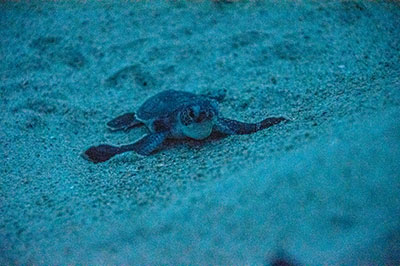
Beaches that are not monitored by the NCWRC, State and Federal Park Staff, or military contractors are managed by volunteer groups permitted and trained by NCWRC. In 2008 the Atlantic Beach Sea Turtle Project volunteer group was formed to assist NCWRC in monitoring sea turtle nesting and stranding activities on Atlantic Beach.

Female sea turtles come ashore to nest, usually at night.
Volunteers patrol the beaches each morning on foot from May 1 through August 31 looking for sea turtle crawls, which they report to volunteer coordinators.

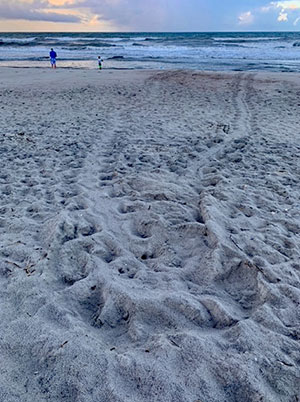
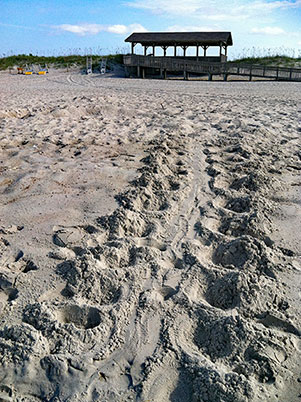


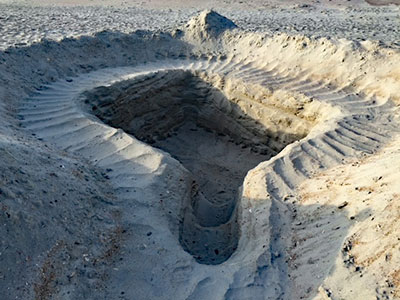
Volunteers also report any threats to sea turtles they find during their morning walk like deep holes that can trap turtles or beach furniture that block nesting grounds. Help sea turtles by filling holes you dig and putting away beach equipment each day.

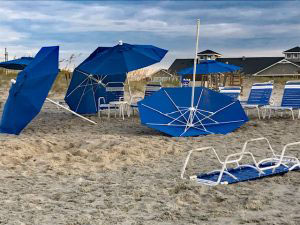
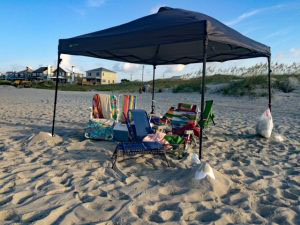

Volunteers while on patrol also pick up trash on the beach that can entangle or be ingested by sea turtles. Helping sea turtles can be as simple as placing trash in proper receptacles.


Occasionally, the mother turtle could be deterred from laying eggs. Instead, she would leave a false crawl because of unfavorable environmental conditions or human interference. A false crawl looks the same as a normal crawl except there are no eggs and sometimes no body pit.

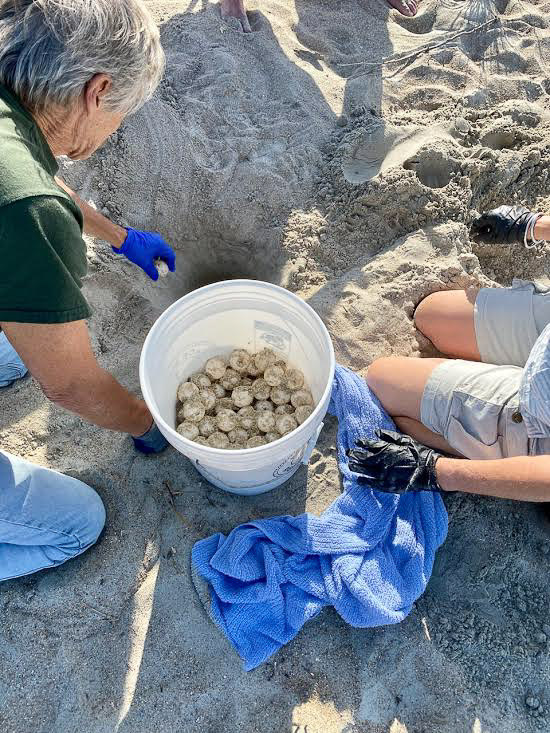
When a nest has been located, nest responders carefully dig into the nest chamber to verify the presence of eggs (right). A single egg is taken for DNA analysis, and the nest is recovered. We use this DNA genetic fingerprinting to identify individual loggerhead nesting females.
On very rare occasions, nests have to be relocated (left). Examples include nests laid below the average high tide line or under a sloping escarpment.

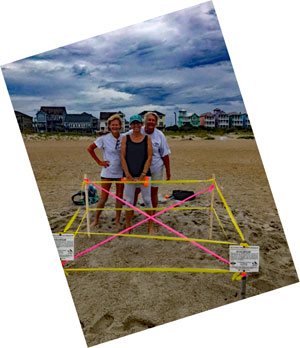
Once a nest is verified by nest responders it is roped off to protect it from foot and vehicle traffic and the nest is documented. The nest will incubate on average between 50-70 days depending on environmental conditions.
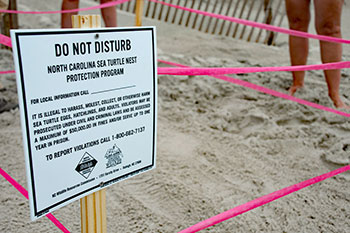

As the nest nears hatching, volunteers will install a shade cloth, smooth a runway to the ocean and start nest sitting at day 50 of incubation. Shade cloth helps protect the hatchlings from misorientation due to light pollution. The sitters sometimes nest sit from 7pm to 7am to make sure the hatchlings make it safely to the ocean.
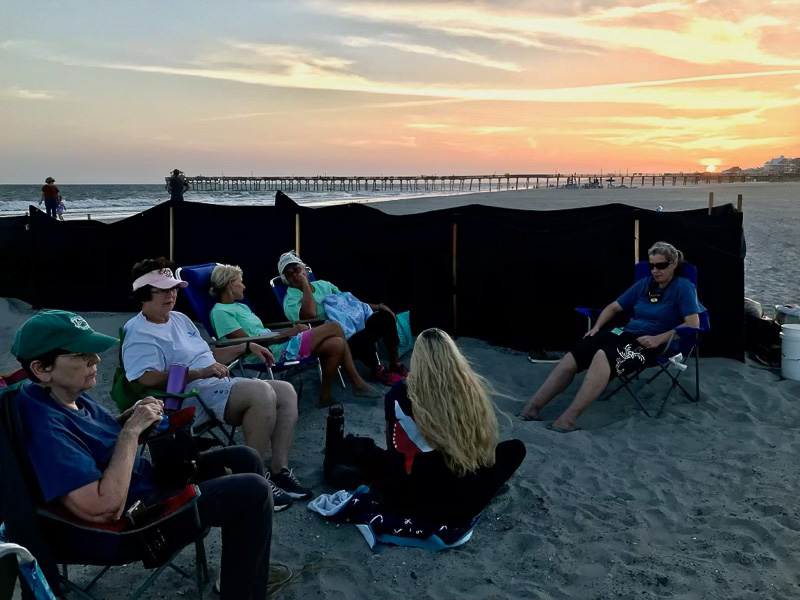

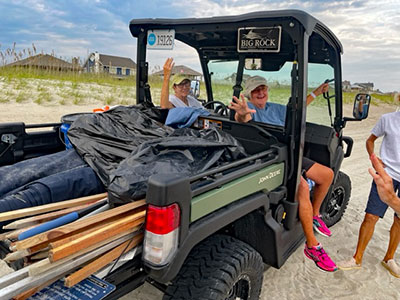
Thanks to funding from our sponsor the Big Rock Foundation, our UTV makes it much easier to move equipment up and down the beach.


At the end of incubation, hatchlings use an egg tooth on the tip of their beak to break open their shells, but they don’t immediately ascend. It takes a few days for the hatchlings the come out of their shells and climb through the sand to the top of the nest. The group moving together up the nesting column can cause a depression of sand above the nest.


The hatchlings’ movements and vocalizations under the sand produce sounds that can often be detected through the use of a hydrophone. Hydrophones use audio sensors placed beneath the sand near the nest to pick up sounds from inside the nest.
Hatchlings typically emerge in large groups at night in what is called a “boil.” When emergence begins, volunteers work to mitigate light and noise pollution and raise public awareness about the emergence process.

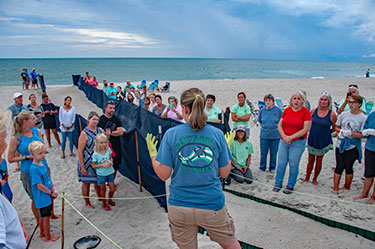
Seventy-two hours after a mass emergence from the nest, volunteers will conduct a nest inventory called an excavation.

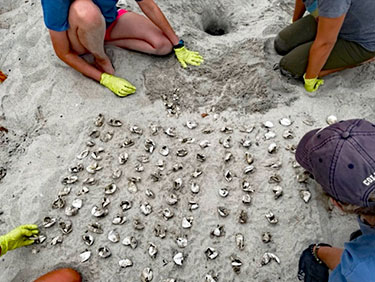
The hatched eggs, whole eggs, live and dead hatchlings are counted and logged into NCWRC’s database.


Any remaining live hatchlings are released, and the contents of the nest are reburied.
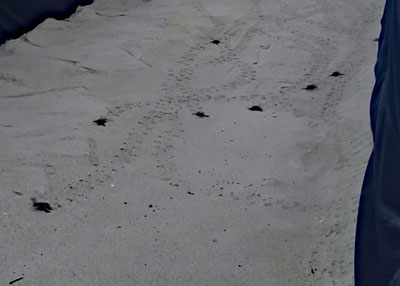

Through this hard work and dedication, the ABSTP volunteers strive to get every last hatchling home to the ocean.

From 2003-2022 there have been 175 recorded sea turtle crawls in Atlantic Beach. Of those, 92 resulted in nests. From 2003-2014 all crawls were made by loggerheads, but in 2015, 2021 and 2022 Atlantic Beach had green sea turtle crawls (three resulted in nests). While most nests have on average 80-120 eggs, our 2022 green nest had 170 eggs. In 2020 the most endangered of all sea turtles, a Kemp’s ridley, laid a nest right here in Atlantic Beach.
Atlantic Beach has also been part of the Northern Recovery Unit Loggerhead DNA Project since 2010. This is a multi-state genetic research project that works with the University of Georgia to individually identify nesting sea turtles. All sea turtles are protected species ranging from threatened to critically endangered status and this project is helping answer nesting census questions.
From the project we have learned we have 37 unique DNA fingerprints (individual females) that have nested in AB from 2010-2021. In addition, we’ve learned that most sea turtles don’t nest every year (instead nest every 2-3 years), can lay 1 to 8 nests per season, and they don’t always come back and nest on the beach that they hatched from. We have had sea turtles in Atlantic Beach that also nest in Virginia, Georgia, and South Carolina. And we have other sea turtles that put ALL their nests between Pine Knoll Shores and Fort Macon.
To Report a North Carolina Sea Turtle Stranding Emergency
Stranding Hotline: 252-241-7367
To Report Sea Turtle Nest Violations
Call NCWRC Hotline: 1-800-662-7137
